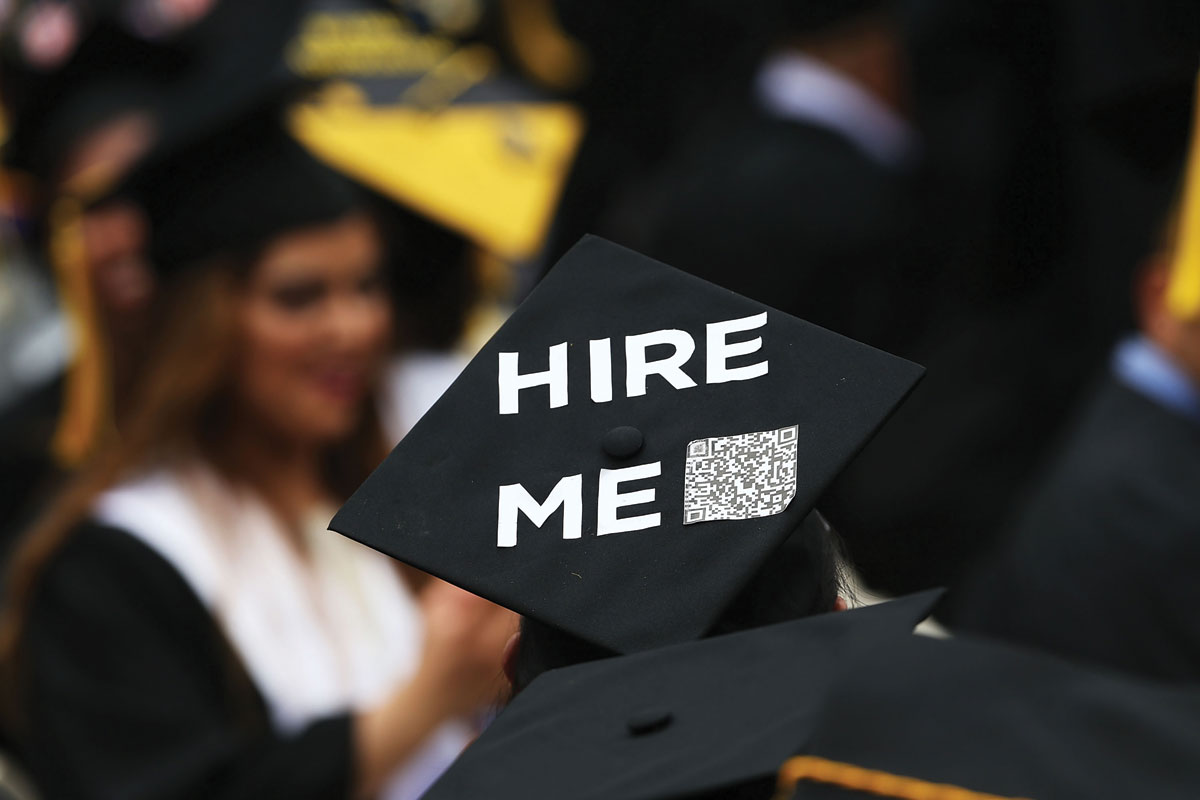Losses of International Students Threaten the American Workforce
A graduating student’s cap declares their future intentions during commencement exercises. (Spencer Platt/Getty Images)
America has a long, proud tradition of immigrants coming to this country in search of a better life for themselves and their families. After earning a prized education at U.S. universities, many of these immigrants have made important contributions to our innovation economy centered in Silicon Valley. Recently, however, I’ve noticed a growing sense of anxiety among international students and their parents who feel they may no longer be welcome in the United States. If this trend continues, it could have long-term damaging effects on American jobs and the overall U.S. economy.
Anti-immigrant rhetoric has flared up as part of the political discourse since the presidential campaign last year. Recent allegations of hate crimes against immigrants and international students in Kansas, Seattle, and elsewhere have only stoked the sentiment that overseas students may no longer be wanted in this country.
I recently travelled to India to promote higher education in Silicon Valley. Everywhere I went, I found people raising this same concern. Many parents and educational consultants conveyed a widespread sentiment that their students’ safety may be at risk in America. As a result, they said many young people who had planned to study in the United States are now reconsidering their options to attend schools in other countries.
Another related issue involves the current level of uncertainty about U.S. immigration policies, especially for H-1B visas. Such visas are largely issued to retain skilled workers in the tech industry, many of whom are employed by India-based companies. Last year, the U.S. government capped H-1B visas at 85,000, or just more than half of 162,000 H-1B visas issued in 2014.
When we step back and consider all these related issues, it’s critical to recognize the fact that international students are responsible for generating hundreds of thousands of middle-class American jobs right now, today. Those jobs are not only the lifeblood for college educators and administrators, but also for supporting roles filled by cafeteria workers, janitors, nurses, shuttle bus drivers, retailers, clerks and so many others who keep our campuses running smoothly.
This multi-billion-dollar impact on the American economy is substantial. Consider that more than 1 million overseas students generated $32.8 billion for the U.S. economy last academic year alone. That figure comes from NAFSA, the Association of International Educators, the world’s largest nonprofit association dedicated to international education and exchange.
If foreign educations were to be classified as a kind of American “export,” this economic engine would nearly rank as the 10th largest export of the U.S. economy, just behind organic chemicals. That doesn’t even count the untold losses of talented computer scientists, engineers, inventors and innovators who might otherwise plug their technical brilliance into the light sockets of American entrepreneurialism after graduation.
Countless talented leaders in the tech sector came to these shores from India and elsewhere to earn degrees before climbing all the way to the top of their chosen fields. Consider the career paths of such tech luminaries as Microsoft CEO Satya Nadella, Google CEO Sundar Pichai, and Vinod Khosla, the billionaire founder of Khosla Ventures.
Nadella was born in Hyderabad and attended Manipal Institute of Technology before earning his computer science degree at the University of Wisconsin-Milwaukee and his MBA at the University of Chicago. Pichai grew up in Chennai and got his first engineering degree at IIT Kharagpur. He went on to earn his MS in material sciences and engineering from Stanford University, and his MBA from the Wharton School at the University of Pennsylvania.
Khosla, a native of New Delhi, earned an engineering degree at IIT Delhi before coming to the U.S., where he received an MS degree in biomedical engineering and an MBA from Stanford. Khosla went on to co-found the seminal Silicon Valley company, Sun Microsystems, where he was the founding CEO and chairman.
After leaving Sun Micro, Khosla joined the famed venture capital firm of Kleiner Perkins Caufield & Byers, and he also became a charter member of TiE, The Indus Entrepreneurs. In 2004, Khosla branched off to form his own influential VC firm, Khosla Ventures.
It is hard to calculate the total aggregate impact that these three leaders have had on the American economy, both by helping build signature companies and investing in innovative ideas. Yet now a rising wave of doubt about American acceptance of foreign-born students is causing many international learners to rethink their educations. Rather than follow in the footsteps of these visionary role models, many Indian students are now enrolling elsewhere at universities in Canada, Australia or Europe.

Leaving aside the huge cultural void this trend will create for a less diverse American society, it also presents a troubling challenge for the U.S. economy and American innovation. We need to grasp the full economic chain reaction that occurs when an international student opts out of the U.S. educational system. NASFA estimates that for every seven international students enrolled, three U.S. jobs are created and supported by spending for higher education, accommodations, dining, retail, transportation, telecommunications and health insurance.
Last academic year, international students supported 400,812 U.S. jobs for educators and other types of support roles, according to NAFSA. Roughly 142,600 direct U.S. jobs were created in higher education, supplemented by more than 258,200 indirect jobs from related support sectors.
Furthermore, this jobs impact spans the political spectrum across all 50 U.S. states, from sea to shining sea. We know that left-leaning Massachusetts supports 31,550 jobs from 59,436 international students, generating $2.3 billion in annual revenues. At the same time, right-leaning Texas generates 24,269 jobs from 82,184 international students, resulting in $1.9 billion annually.
The politically mixed swing state of Ohio generates 14,142 jobs from 37,752 international students, resulting in $1.1 billion in state revenues each year. Likewise, Florida employs nearly 16,000 workers due to 43,462 in-state international students who yield $1.3 billion annually.
College administrators from Canada, Australia, the UK and elsewhere are actively marketing their best schools as substitutes for students who originally hoped to earn degrees in the United States. On my recent trip to India, I saw numerous broadcast commercials and print advertisements enticing Indian students to study in those alternative countries.
Obviously, we should acknowledge that a great many U.S. workers currently depend on the revenue generated by international students in the U.S. Yet even more importantly, the likelihood of losing large numbers of international students is likely to cost the U.S. much more in terms of global competitiveness.
We should concede that all those students’ new ideas, breakthrough inventions and future startup companies must necessarily be based somewhere around the world. For this reason, it is imperative that we do everything possible to continue to attract them to the U.S. to earn their degrees and launch their careers.



Sadly, Trump’s contentious issue is yet one more thing that makes being an international student difficult, on top of our already complex culture and language. Assimilation assistance must come from numerous sources to aid these young people embarking on their life’s journey. Most struggle in their efforts and need guidance from schools’ international departments, immigration protection, host families, concerned neighbors and fellow students, and even informative books to extend a cultural helping hand so we all have a win-win situation.
An award-winning worldwide book/ebook that reaches out to help anyone coming to the US is “What Foreigners Need To Know About America From A To Z: How to Understand Crazy American Culture, People, Government, Business, Language and More.” It is used in foreign Fulbright student programs and endorsed worldwide by ambassadors, educators, and editors. It also identifies “foreigners” who became successful in the US and how they’ve contributed to our society, including students.
A chapter on education explains how to be accepted to an American university and cope with a confusing new culture, friendship process and daunting classroom differences. Some stay after graduation. It has chapters that explain how US businesses operate and how to get a job (which differs from most countries), a must for those who want to work with/for an American firm here or overseas.
It also has chapters that identify the most common English grammar and speech problems foreigners have and tips for easily overcoming them, the number one stumbling block they say they have to succeeding here.
Good luck to all wherever you study or wherever you come from, because that is the TRUE spirit of the American PEOPLE, not a few in government who have the loudest voice!